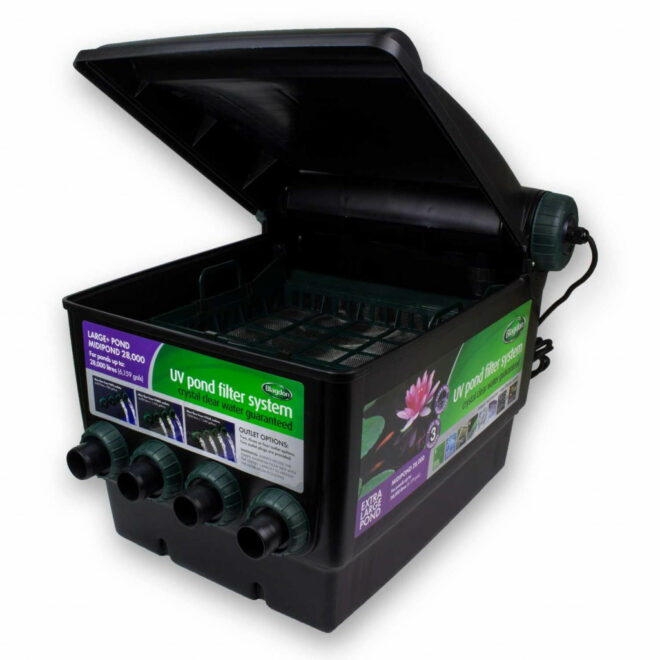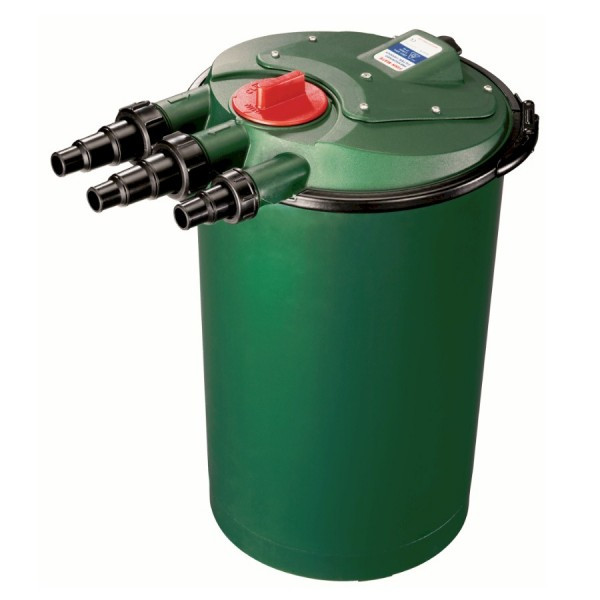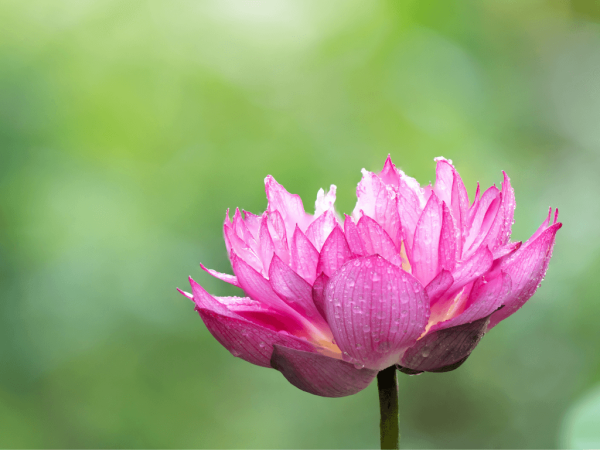How to choose a pond filter and UV
Do you need a pond filter, and if so, which one? We show you your options in this easy to follow guide to pond filtration.
You need a pond filter in order to achieve one or both of the following things: Clean, clear water, or a healthy environment for fish. Pond water often goes green, and the combination of a pond pump, pond filter and an ultraviolet clarifier can prevent the common problem of green water.
Pond fish also produce waste but are not equipped to live in their own waste, so fish pond filters can convert fish waste and prevent it from getting polluted. If you want clear water and healthy fish, you need a filter.
Which box filter for my pond?
Box filters are simple plastic boxes containing a variety of mechanical and biological filter media. Water is pumped into the box by a pump situated in the pond, and connected to the pump by pond hose.
Pond water is pumped into the top of the box and drips through filter media via gravity. Physical waste is trapped, typically in sponges, before passing through biological media containing beneficial bacteria, and returning to the pond.
Box filters are simple and effective, and one containing mechanical and biological filtration media will be capable of supporting fish, breaking down their waste, and clearing the water of debris. A box filter won’t prevent green water however unless it has a built-in ultra violet clarifier (UVC) or you fit a separate UVC to the pipework between the pump and the filter.
Why choose a box filter?
Box filters are suitable for all sizes of garden ponds, and are simple to maintain, just by taking the lid off and squeezing the dirty sponges in old pond water. If they get very dirty most have a built in bypass, meaning that water will still circulate, offering essential oxygen to pond fish.
They are a basic pond filter but its simple to add additional biological media or chemical filter media like carbon or zeolite, and beneficial bacteria products can be dropped or poured into the media, getting to work straight away.
There are two small negatives with box fish pond filters - firstly they are large, so may be unsightly if situated at the poolside and not hidden, and secondly, as they work via gravity, they need to be situated at the highest place in the system for water to return via gravity to the pond.
This means that if you have a waterfall, the box filter must be placed at the top of the waterfall, as it can’t be placed poolside, and then water exit uphill to the top of the waterfall. Water would flood the box. But if you don’t have a waterfall, can place it near or next to the pond, and want a lot of filter for your money, box filters are an excellent choice.

Which pressure filter for my pond?
Pressurised pond filters are cylindrical canisters with a tight fitting lid. Just like box filters they contain biological and mechanical filter media, water is pumped to them by a pump in the pond, and models with built in UV are available to prevent green water.
But unlike box filters, water exits the filter at pressure, not by gravity. This means that the filter can then be placed some distance from the pond or at the base of a waterfall, and an extra pond hose can then take water up to feed the waterfall.
Pressure filters can even be partially buried up to their lids, for the most discreet placement of any pond filter. Its their compact size and numerous benefits that make pressurised pond filters the most popular filter systems for garden ponds.
How to clean a pressurised pond filter
Pressure filters vary in their ease of cleaning. Basic models involve unsealing the lid, removing the sponges and squeezing them in old pond water, just like box filters. But advanced pressure filters enable sponge cleaning without getting your hands wet, and even flushing that dirty cleaning water to waste via a third outlet.
Pressure filters can produce very clean, clear water as the water is forced through the media and can’t bypass via an easier route, but they can block if not cleaned regularly, and flow through the pond will reduce. If you have a very large pond, or large Koi carp, you may also want to choose a different type of filter, which is capable of handling more solid and biological waste.

Which Koi filter for my pond?
Koi carp can grow very large, up to a metre in length, and with that comes lots of food and lots of waste. Koi ponds are typically designed with large fish and large amounts of waste in mind, and are deep, with nothing to cause or collect waste in the pond like pond plants. Koi may eat plants too.
And unlike standard box and pressure filters, koi ponds are often run as gravity fed systems, with a bottom drain and surface skimmer built into the base and side of the pond, then a large filter is placed next to the pond, and pump and uvc are outside of the pond too.
With gravity fed pond filtration, water overflows from the pond down large, rigid pipework, drawing fish waste with it. Once in the filter waste is physically removed first, then treated biologically by lots of biological filter media, before a powerful external pump sucks water from the filter, pumps it through a UVC, then returns it to a pond.
Koi filters deal with so much muck and fish waste that some don’t use sponges at all, as they would get dirty very quickly. Instead, they trap or prevent waste from travelling further and allow flushing of that waste via drain valves, before the biological filter has to break it down.
Why choose a koi filter?
Standard box and pressure filters can be used for koi, but most experienced koi owners, with large fish and large ponds, choose gravity fed koi filtration systems. Koi filters can also be pump fed in the standard way, with a pump in the pond, and hose connecting pump to filter.
But if you choose the gravity fed route the pond will need to be designed and built differently from scratch, in order to install the bottom drain (which is fixed into concrete,) and the surface skimmer in the pond wall.

Which All-in-one pond filter?
At the other end of the scale, if you have a small pond and want clear, healthy water with the minimum of equipment, an all-in-one pond filter may be what you need. All-in-one pond filters combine the pump, filter media and UVC in one small unit.
Place the unit into the pond water and it will do everything that smaller ponds require. They also often come with fountain attachments and hose tails to enable a small watercourse to be powered at the same time. They are small, convenient and very cost-effective.
What are the limitations of All-In-One pond filters?
All-in-one pond filters are only designed for small pond filtration however, and if used as the sole form of filtration in large fish ponds, they may fail to break down all the waste and keep the water clear, or they may clog up.
But keep them within their maximum water volume limitations and you’ll be fine. And with that filter media inside the unit itself, you will need to remove the whole unit from the bottom of the pond each time in order to clean the media, which can mean cold, wet hands in winter.

FAQs on pond filters
How do I calculate pond volume?
You can calculate your pond volume in litres in the following way: Length x width x depth in metres, x 1000.
So a 2.4 x 1.8 x 0.6m pond =2.592 cubic metres, x 1000 = 2592 litres. Round the volume up to the nearest 500 litres and you’ll need a filter and UVC for 3000 litres volume. For koi carp, pond keepers often double the filter capacity again, so aim for a filter capable of filtering 6000 litres volume, for the above pond with koi.
Can I over-filter a pond?
Ponds in full sun, or containing koi, may need extra help in order to maintain crystal clear water. There is no limit to the size of pond filter you put on your pond, and the larger the filter and UVC, the better your water quality will be.
When do I give the pond filter a boost with bacteria?
All brand new pond filters will be effective at trapping waste, but not converting ammonia and nitrite from fish waste until they mature. Beneficial bacteria can also die off due to the use of medications, replacing old media with new, or power cuts, so in all cases beneficial bacteria should be used to bring the biological filter to life.
I have a top of the range filter but my pond has blanketweed. Why?
No pond filter and UVC will prevent the growth of blanketweed, and it needs to be treated separately with dedicated blanketweed treatments. This is because it grows on the poolside and doesn’t travel through the filter or UVC.
For more pond essentials, check out our range of pond liners and pond pumps.









